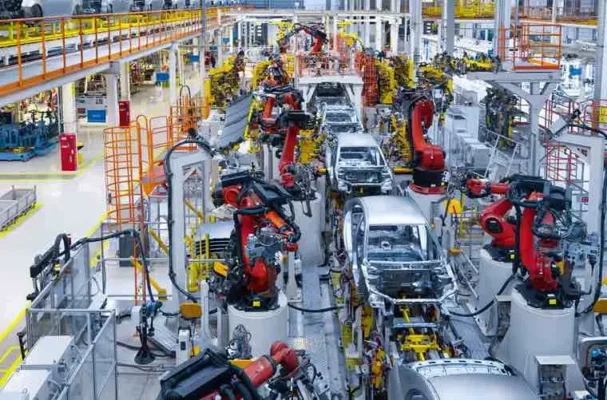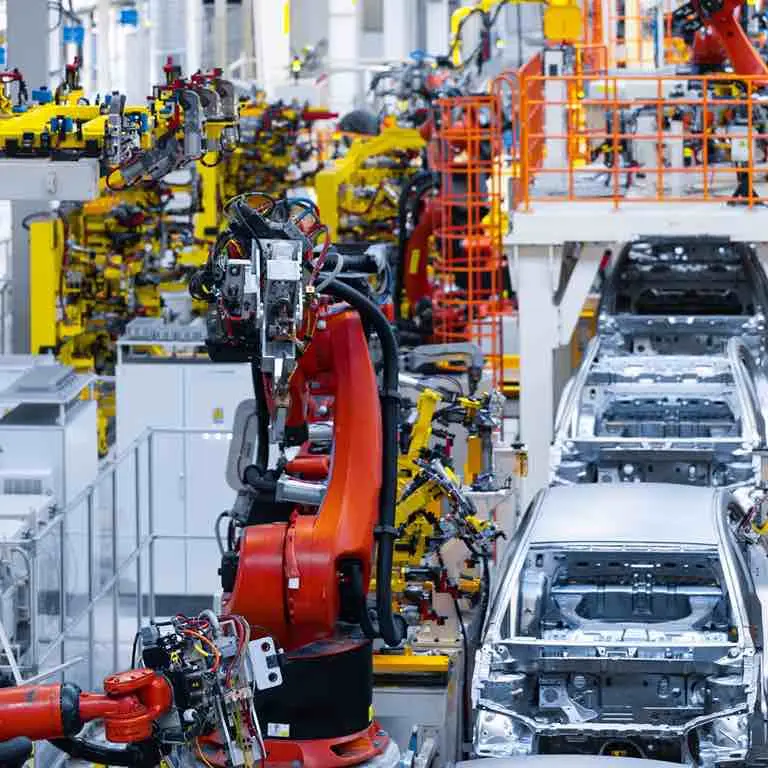Robots are essential in automotive manufacturing, driving your production line’s efficiency and quality. Whether you’re focused on assembly, painting, or material handling, robots can help you reduce costs and maintain high standards. If you’re considering automating your processes, understanding the different types of robots available is crucial. This knowledge will help you make informed decisions that fit your specific needs and goals.
Let’s explore the robotic solutions that can take your manufacturing to the next level, ensuring you stay competitive in a demanding industry.
Types of Robots in Automotive Manufacturing:
Industrial Robots:
You’ll see Six-axis, SCARA, and Cartesian robots in most automotive plants. These robots handle welding, assembly, and material handling. They are precise and fast, making them ideal for tasks that require consistency.
Collaborative Robots (Cobots):
Cobots are safe to work alongside your team. They are great for tasks like small parts assembly. Cobots easily integrate into your current setup, boosting productivity without compromising safety.
Autonomous Mobile Robots (AMRs):
AMRs handle material transport in your factory. They move parts where needed, reducing delays and keeping your production line efficient.
Why You Need Robots in Automotive Manufacturing:
Staying Competitive:
You need robots to stay ahead in the automotive industry. Automation helps you produce vehicles faster and with higher quality, keeping you competitive.
Meeting Demand:
Robots boost your production speed, allowing you to meet growing demand without compromising on quality.
Improving Safety:
By using robots for hazardous tasks, you create a safer environment for your team. This reduces accidents and keeps your workforce focused on safer duties.
Enhancing Quality:
Robots ensure precision in every step of your production process, helping you maintain consistent quality in your vehicles.
Looking to enhance your automotive manufacturing with robotics? Use Alina, your AI Automation Consultant from Qviro, to explore the best robotic solutions for your needs. Let Alina guide you to the right technologies and strategies to optimize your production line. Get started with Alina now!
Key Applications of Robotics in Automotive Manufacturing:
Spot Welding:
You rely on robots for spot welding due to their precision and consistency. They’re essential in body-in-white (BIW) assembly lines where accuracy is critical.
Painting:
Robots handle painting tasks with precision, ensuring an even coat every time. This reduces waste and maintains the quality of your car bodies and parts.
Material Handling & Part Transfer:
Robots move parts between workstations efficiently, minimizing errors and speeding up your production process.
Machine Tending:
Robots operate your CNC machines and presses, helping you increase uptime and cut down on labor costs.
Inspection & Quality Control:
Automated inspection systems catch defects early, ensuring your products meet strict quality standards.
Benefits of Using Robots in Automotive Manufacturing:
Increased Efficiency & Productivity:
Robots operate around the clock without breaks. This means your production line stays active, boosting output and reducing downtime.
Cost Savings:
By using robots, you lower labor costs and minimize material waste. This helps you get the most value from your resources.
Improved Safety:
Robots handle dangerous tasks, keeping your team out of harm’s way. You can prioritize safety while maintaining productivity.
Consistency & Precision:
Robots ensure every product meets your standards. Their accuracy guarantees uniformity in your production, which is crucial in the automotive industry.

Common Misconceptions About Robotics in Manufacturing:
Robots Replace Human Jobs:
You might worry that robots will take away jobs, but they typically handle repetitive or dangerous tasks. This lets you shift your team to more valuable roles that require human skills and creativity.
Robots Are Too Expensive:
Yes, the upfront cost is high, but the savings you’ll see in labor, efficiency, and reduced waste can pay off within 1 to 3 years. In the long run, robots often save more money than they cost.
Robots Are Hard to Integrate:
If you’re concerned about integrating robots, know that modern robots, especially cobots, are designed to fit smoothly into your current processes, making the transition easier than you might expect.
Tips for Implementing Robotics in Your Manufacturing Process:
Assess Your Needs:
Identify the tasks that will benefit most from automation, like repetitive or hazardous jobs. Focus on where robots can add the most value.
Choose the Right Robots:
Pick robots that match your specific needs. Cobots work well for flexible tasks, while AMRs excel at material handling.
Plan for Integration:
Check that your current systems can support the new robots. You might need to upgrade software or adjust workflows to ensure a smooth integration.
Train Your Team:
Provide training for your staff to work effectively with the new robots. This helps them manage and maintain the equipment.
Start Small:
Begin with a pilot project. This allows you to test the robots and address any issues before expanding their use.
Following these steps will help you integrate robots smoothly into your manufacturing process and maximize your investment.
Ready to start your cobot project? Follow these steps to make sure everything goes smoothly. Get the clear, practical advice you need in our blog!
Challenges in Implementing Robotics:
Initial Investment Costs:
The upfront costs for robots and automation can be high. You’ll need to budget for not just the robots but also the infrastructure to support them.
Integration with Existing Systems:
Fitting new robots into your current production line can be tricky. You may face challenges adapting older systems to work with modern robotics.
Skilled Labor Shortage:
Finding skilled technicians to maintain and operate your robots can be difficult. You’ll need to invest in training or hiring specialists to keep your systems running smoothly.
Cost-Benefit Analysis of Robotics in Automotive Manufacturing:
Initial Costs:
Investing in robots is a big decision. Industrial robots usually cost between $50,000 and $150,000 each. On the lower end, cobots range from $20,000 to $50,000, while AMRs can cost you $30,000 to $100,000. You’ll also need to factor in setup costs, which can add another $100,000 to $200,000.
Operational Savings:
Robots help you save on labor and reduce material waste. For example, AMRs can handle material transport, cutting down on manual labor, while cobots take over repetitive tasks, saving you money over time.
Return on Investment (ROI):
With faster production and fewer defects, you can expect a solid ROI. Most companies see a payback within 1 to 3 years, making this investment worthwhile for your long-term success.
Explore the best ways to finance your robot solution and make informed decisions to fit your budget in our blog.
Future Trends in Automotive Robotics:
Advancements in AI & Machine Learning:
Robots are getting smarter with AI and machine learning. This means they’ll learn and adapt to your specific needs, making your production process more efficient.
Increased Use of Cobots:
You’ll see more collaborative robots (cobots) in the future. Cobots work safely alongside your team and offer flexibility in handling different tasks.
Sustainability Focus:
Future robots will focus on using less energy and producing less waste. This helps you meet your sustainability goals while maintaining efficiency.
Industry 4.0 Integration:
Smart factories are the future. Your robots will be part of an interconnected system, where machines communicate and data drives your operations, making everything more streamlined.
Conclusion:
Adopting robotics in your automotive manufacturing process is key to staying competitive and meeting demand. Robots help you improve efficiency, cut costs, and enhance safety by taking on risky tasks. With advancements in AI, more collaborative robots, and a focus on sustainability, automation will continue to shape the future of your industry. By integrating these technologies, you can streamline your production and maintain high quality in a fast-changing market. Now is the perfect time to explore how robots can benefit your operations.






